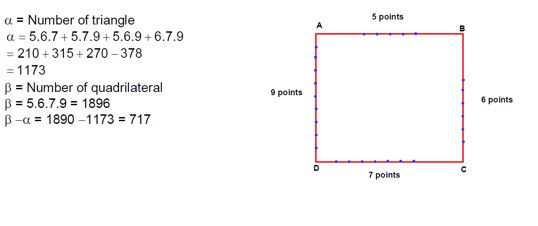Permutations and Combinations
Get insights from 121 questions on Permutations and Combinations, answered by students, alumni, and experts. You may also ask and answer any question you like about Permutations and Combinations
Follow Ask QuestionQuestions
Discussions
Active Users
Followers
New answer posted
a month agoContributor-Level 10
Digits are 1, 3, 5, 7, 9. We need to form a 6-digit number where exactly one digit is repeated.
Choose the digit to be repeated:? C? ways.
Choose the positions for these two repeated digits:? C? ways.
Arrange the remaining 4 distinct digits in the remaining 4 places:? P? = 4! ways.
Total numbers =? C? *? C? * 4! = 5 * 15 * 24 = 1800.
The solution in the image 5/2 (6!) seems to follow a different logic which is unclear. 5 * (6!/2) = 5 * 360 = 1800. This logic is: choose one of 5 digits to repeat. Arrange the 6 digits, and since two are identical, divide by 2!
New answer posted
a month agoContributor-Level 10
We want to evaluate S = ∑ (r=1 to 10) r! (r³ + 6r² + 2r + 5).
We can rewrite the polynomial r³ + 6r² + 2r + 5 as (r³+6r²+11r+6) - 9r - 1.
Note that (r+1) (r+2) (r+3) = r³+6r²+11r+6.
So the term is r! [ (r+1) (r+2) (r+3) - 9r - 1] = (r+3)! - (9r+1)r!
Rewrite 9r+1 as 9 (r+1) - 8.
The term is (r+3)! - [9 (r+1)-8]r! = (r+3)! - 9 (r+1)! + 8r!
Let T? = (r+3)! - 9 (r+1)! + 8r! This does not form a simple telescoping series.
Following the OCR's final calculation, the sum simplifies to 13! + 12! - 8 (11!).
= 11! (13*12 + 12 - 8) = 11! (156 + 4) = 160 (11!).
New answer posted
a month agoContributor-Level 10
Let x = m(a + λb).
Given m(a + λb) ⋅ (3i + 2j - k) = 0, which leads to λ = -3/8.
The projection of vector x on vector a is given by x ⋅ â, where â is the unit vector of a.
Projection = (x ⋅ a) / |a| = 17√6 / 2
x ⋅ a = (m(a + λb)) ⋅ a = m(a ⋅ a + λ(b ⋅ a)) = m(|a|^2 + λ(b ⋅ a))
The provided text simplifies this to:
m(6 - 3/8 * (-1)) = 17√6 / 2
m * (51/8) = 17 * 6 / 2 (The text seems to have a typo 17x6/2 instead of 17√6 / 2)
Assuming it is 17 * 6 / 2, m * 51/8 = 51, so m = 8.
x = 8(a + (-3/8)b) = 8a - 3b
x = 8( (13/8)i - (14/8)j + (11/8)k ) (The vectors a and b are not fully defined in the provided text)
The final vec
New answer posted
a month agoContributor-Level 10
f (x) = ∫ (5x? + 7x? ) / (x² + 1 + 2x? ) dx seems to have a typo in the denominator. Based on the solution, the denominator is (x? + 1/x? + 2)² or similar. Let's follow the solution's steps.
It seems the denominator is (x? (2 + 1/x? + 1/x? )² = x¹? (2 + 1/x? + 1/x? )².
f (x) = ∫ (5x? + 7x? ) / (x¹? (2 + 1/x? + 1/x? )²) dx
The solution simplifies the integrand to:
f (x) = ∫ (5/x? + 7/x? ) / (2 + 1/x? + 1/x? )² dx
Let t = 2 + 1/x? + 1/x?
dt = (-5/x? - 7/x? ) dx = - (5/x? + 7/x? ) dx.
The integral becomes:
f (x) = ∫ -dt / t² = 1/t + C.
f (x) = 1 / (2 + 1/x? + 1/x? ) + C.
Given f (0)=0, this form has a division by zero. Let's re-ex
New answer posted
a month agoNew answer posted
a month agoContributor-Level 10
S-2, L-2, A, B, Y, U
Required = ²C? ⋅? C? ⋅ 4!/2! = 2 ⋅ 10 ⋅ 24/2 = 240
New answer posted
a month agoContributor-Level 9
The word is 'LETTER'.
Consonants are L, T, R.
Vowels are E, E.
Total number of words (with or without meaning) from the letters of the word 'LETTER' is:
6! / (2! 2!) = 720 / 4 = 180.
Total number of words (with or without meaning) from the letters of the word 'LETTER' if vowels are together:
Treat (EE) as a single unit. We now arrange {L, T, R, (EE)}. This is 5 units.
Number of arrangements = 5! / 2! (for the two T's) = 120 / 2 = 60.
∴ The number of words where vowels are not together = Total words - Words with vowels together
Required = 180 - 60 = 120.
New answer posted
a month agoContributor-Level 10
Ways of selecting correct questions =? C? = 15
Ways of doing them correct = 1
Ways of doing remaining 2 questions incorrect = 3² = 9
∴ No. Of ways = 15 * 1 * 9 = 135
Taking an Exam? Selecting a College?
Get authentic answers from experts, students and alumni that you won't find anywhere else
Sign Up on ShikshaOn Shiksha, get access to
- 65k Colleges
- 1.2k Exams
- 688k Reviews
- 1800k Answers

